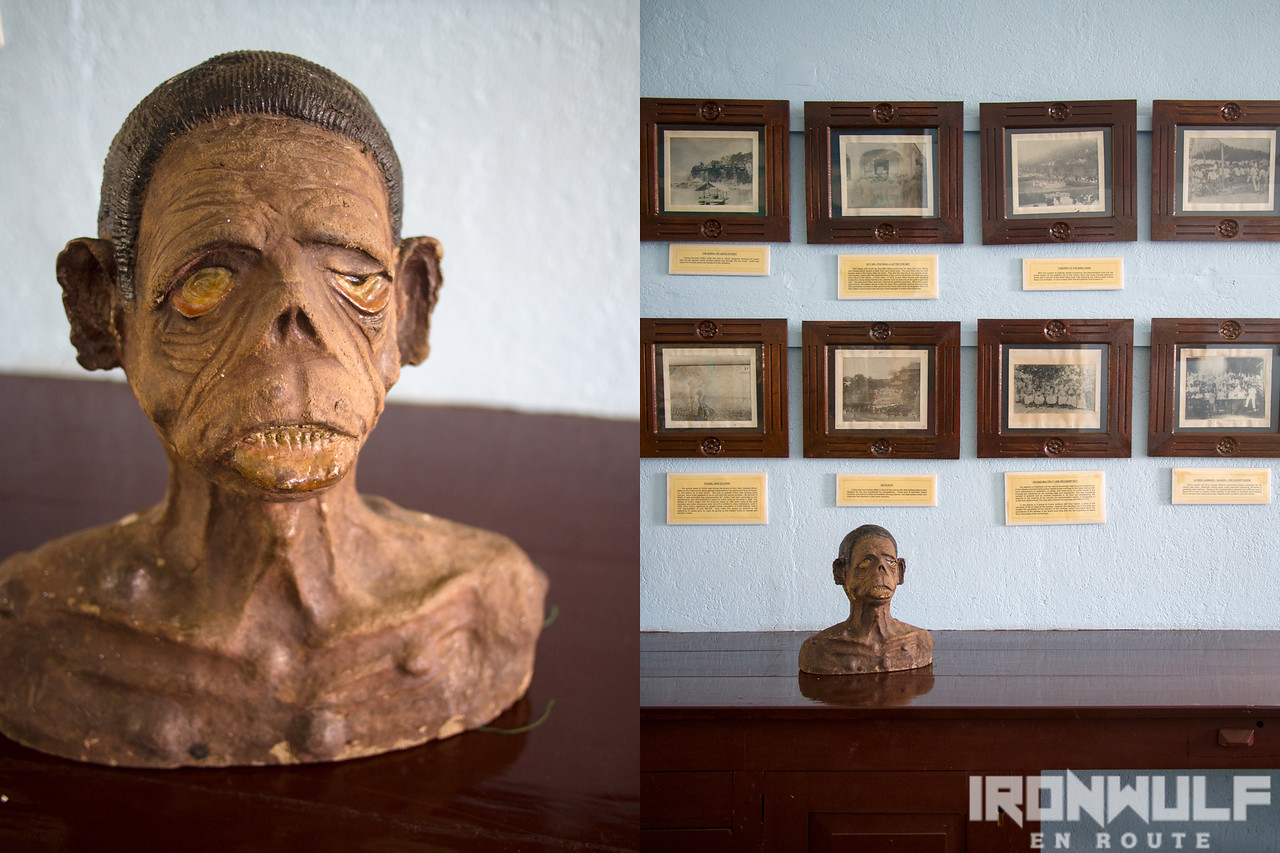“I knew that man during my younger years. When I see that bust, I can still imagine him speaking to me” said Pastor Hermie, our guide for that day as we ventured to the farther south regions of Culion Island on a motorbike. He was referring to the grotesque bust figure greeting visitors of the Culion Leprosy Museum and Archive after a flight of stairs to the 2nd floor. Just the thought that the figure was an actual leper sent a chill on my spine as I imagine his mummified figure. Stories such as this is common in Culion Island, whose present inhabitants are one way or another are 2nd or 3rd generation descendants of the thousands of leprosy patients who lived on the island. Its hard not to talk about the leprosy stigma that has befallen Culion when visiting the island and a good starting point to learn more about it is a visit to the Culion Leprosy Museum and Archive within the General Hospital compound.
The Museum
We had to wait for caretaker Mauricio to open the museum for us. With rationed electricity and limited visitors, they only open the Museum when needed. There’s a Php 50 entrance fee payable at the General Hospital cashier. The lights were open, I could hear the cooling system kicking in and the displays took a life on its own. I’m impressed on how the museum was curated. The lighting was warm and spotlight on the items leads my eye where it should be. We learned the walls were recently lending to its new feel. Displays are properly labeled and once in a while, Mauricio would add in some trivia. I went through the sequence and let the display speak about their history.

Life in the Culion Leper Colony
We can say history started in Culion Island on May 27, 1906 when the first batch of 370 patients came from Cebu in accordance with the “Segregation Law on Leprosy”. The original inhabitants left their homes to live on nearby islands, selling their houses and lands. But things didn’t go simple for the leprosy-inflicted, instead of calling them simple patients they were called “inmates” like criminals in prison. The people inside the leper colony tried to continue with their regular life on the island while being treated. Like an independent nation Culion Island even had their own currency they use for trade and work. People still fall in love but they were not encouraged to get married and as their children may also be inflicted with leprosy. That didn’t stop them from tying the knot though and having babies. Photos and clips of their lives inside the colony can be seen on the ground floor as well as the currencies they have used. Displays of how patients were treated, the tools and photographic transformations of some of the patients after being treated.

Healing Leprosy
For the period of every 3 months, new batches of leprosy patients would come in. By 1910 about 5,303 patients were brought in Culion, then regarded as the world’s largest leper colony, 3,154 of those died from leprosy complications, 33 who were officially cured were “paroled” and 114 were absconded. The rise of fatality rate was due to inadequate equipment and shortage of personnel. It was only in 1911 when more help came from different sectors. Use of Chaulmoogra (an herbal oil from the said tree) was used to treat leprosy and there were segregation done on patients depending on the degree, from the mild to the severe.
In 1920, interest on finding better treatment for leprosy became strong, more funding came in. At that, time Culion became the leading institution in the world for leprosy research and experimental treatment, due to the large number of patients and willing volunteers to undergo experimental procedures. This even attracted prominent leprologist around the world to the island. The 2nd floor of the museum hold the tools and paraphernalia researchers used to find ways to treat leprosy. Eventually by 1930s, leprosaria centers in 8 strategic regions in the country were established for treating “mild” cases of leprosy reducing the number of incoming patients to the island. By 1952, people were now allowed by law to be treated at home under certain conditions which further reduced the population of people in Culion eventually making the sanitarium function as a medical facility later on.

A Link to the Past
The visit to the Culion Leprosy Museum and Archive was an enriching experience that would shed light to what really transpired on this island. The museum not only holds tangible records and archive of the island’s past but is a link to the collective memory of the people. As we leave the museum the caretaker Mauricio revealed his full name by pointing to the plaque at the museum, Marucio Leal. He was the son of a former patient who worked on the hospital and the museum for decades. With understanding of the island’s past, the feeling of dread was replaced by hope and optimism.
*Reference notes from Art Punzalan’s article “All the Things We Cannot Articulate: Colonial Leprosy Archives and Community Commemoration” and the article on “History of Culion Sanitarium and General Hospital”


Ferdz Decena is an award-winning travel photographer, writer and blogger. His works has found print in publications such as Singapore Airlines’s Silver Kris, Philippine Airlines’ Mabuhay, Cebu Pacific’s Smile and Seair InFlight. He has also lent his expertise to various organizations like the Oceana Philippines, Lopez Group Foundation, Save the Children and World Vision, contributing quality images for their marketing materials.
